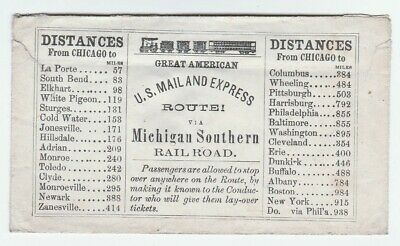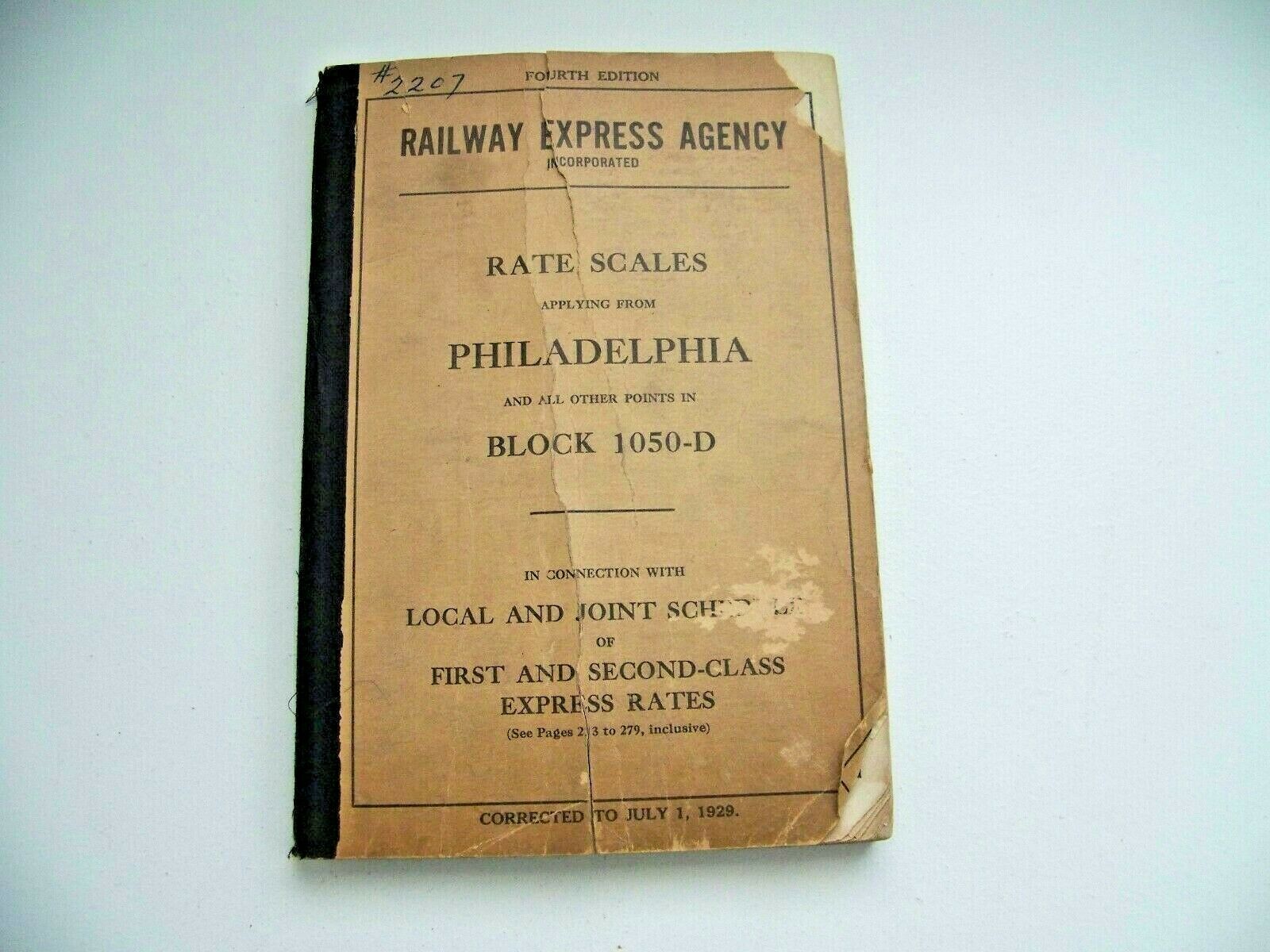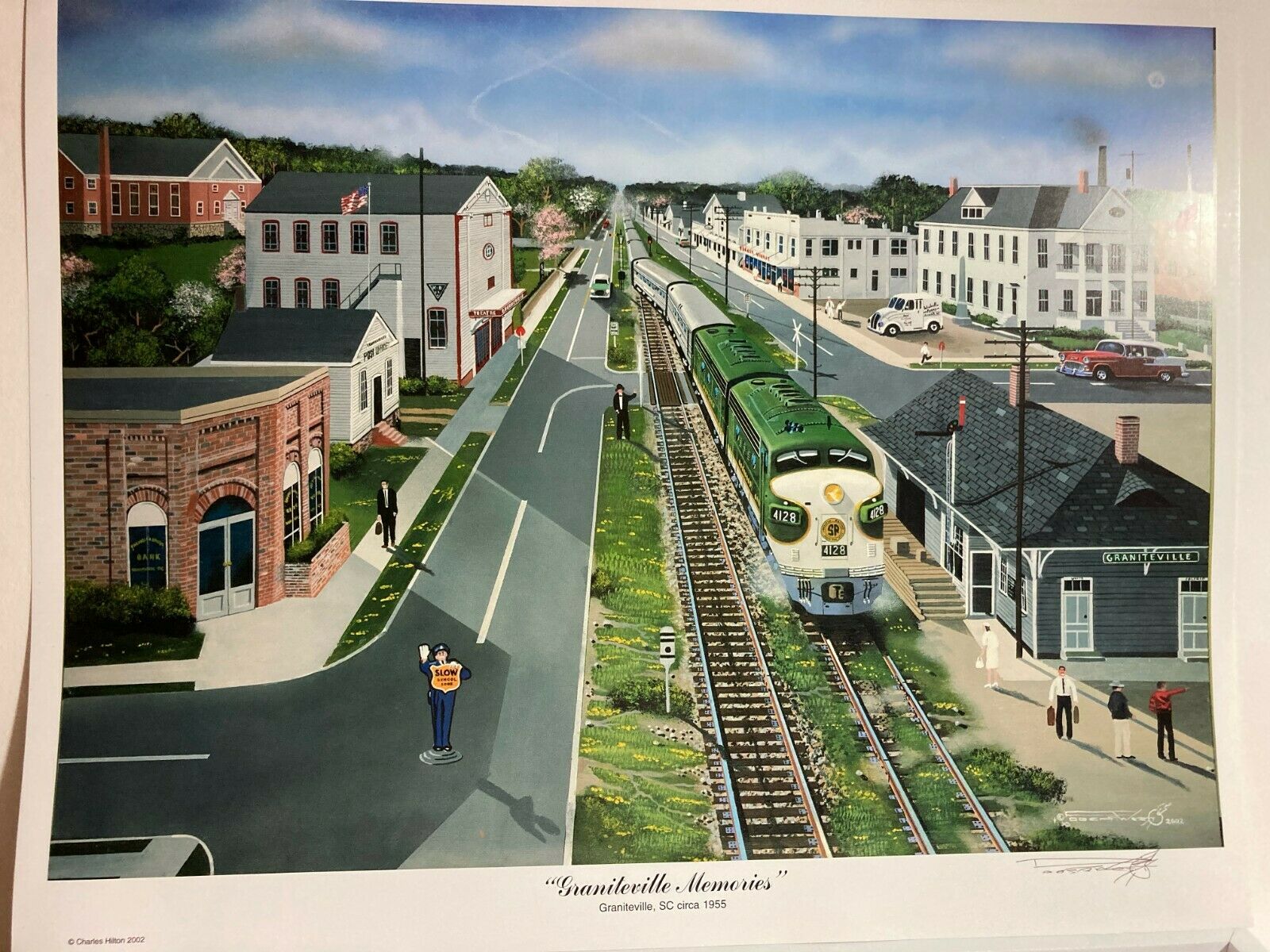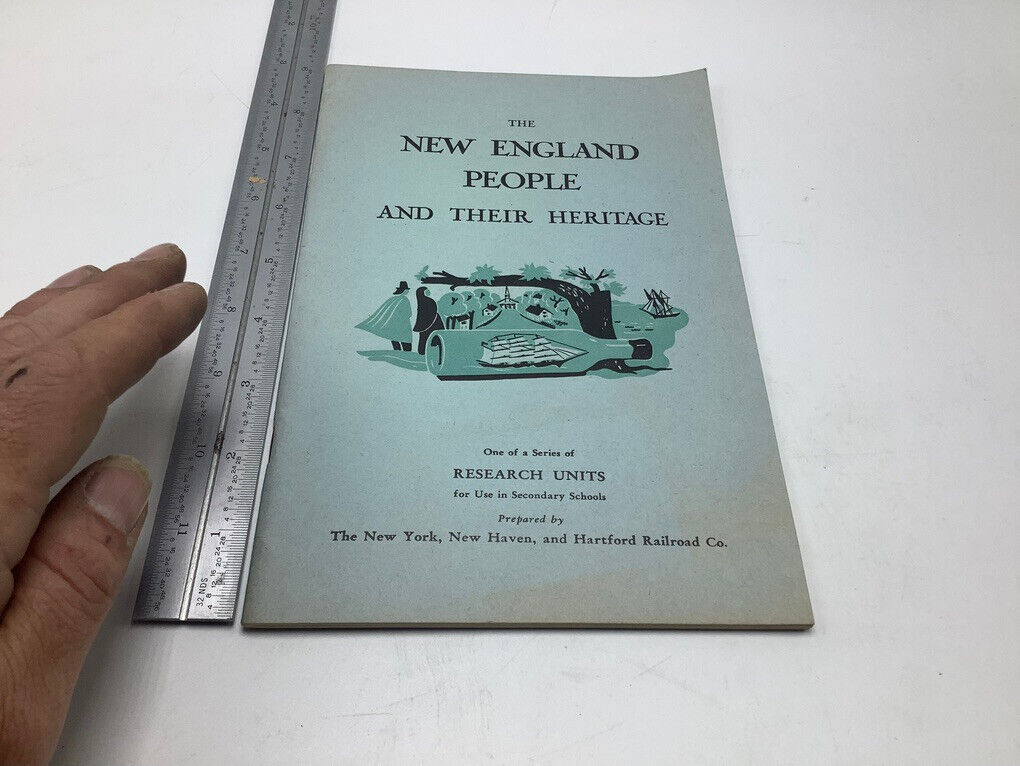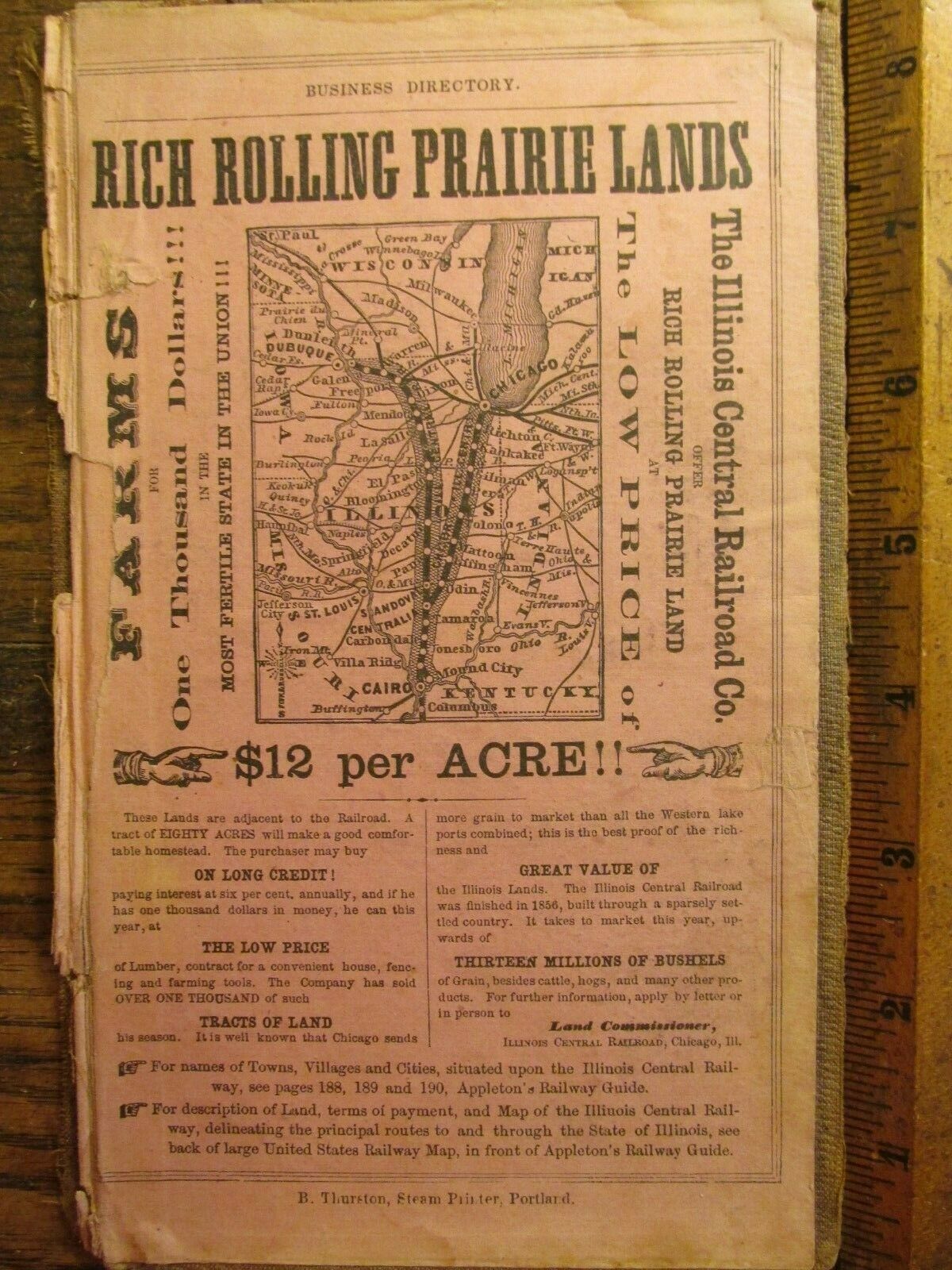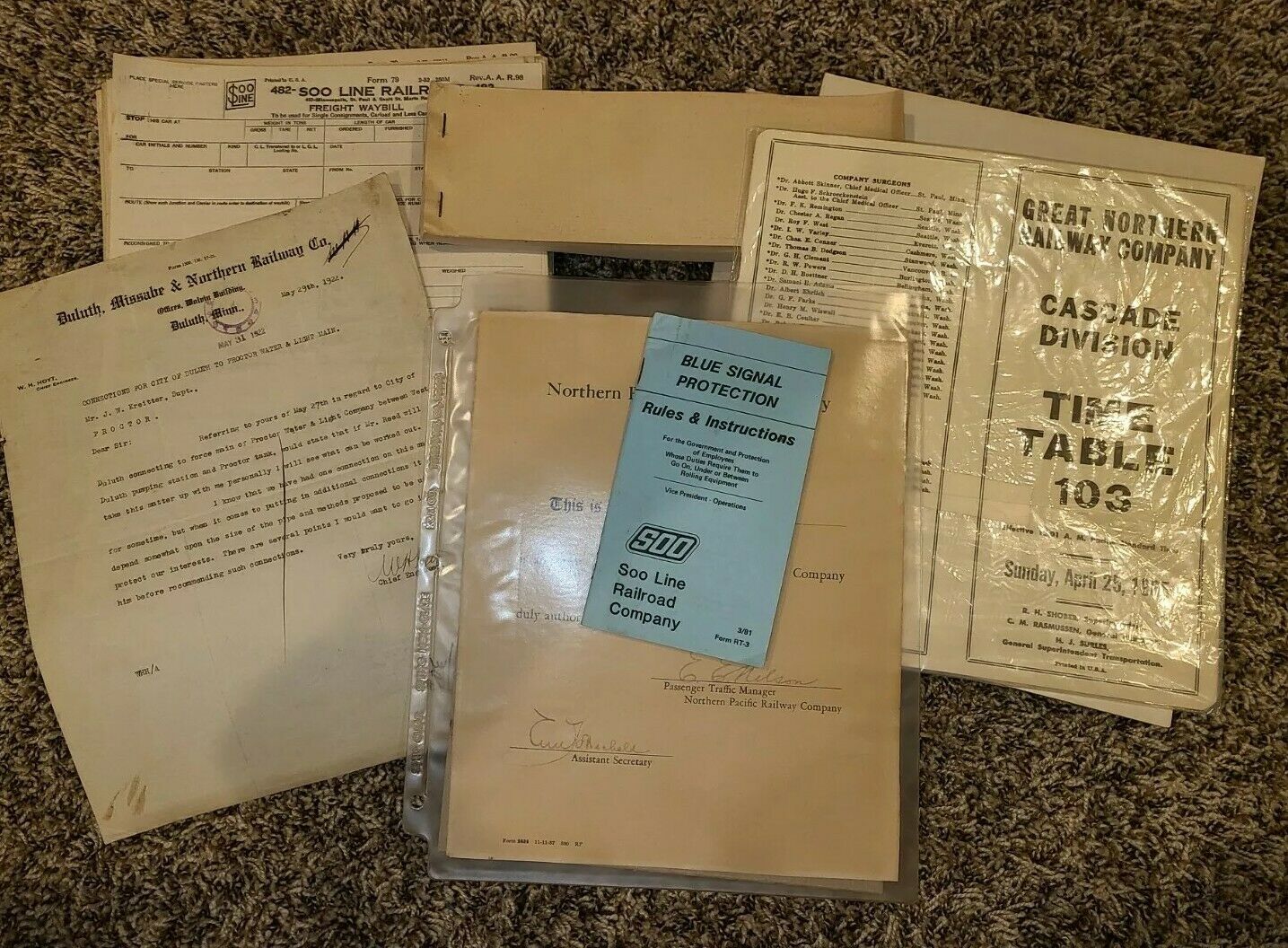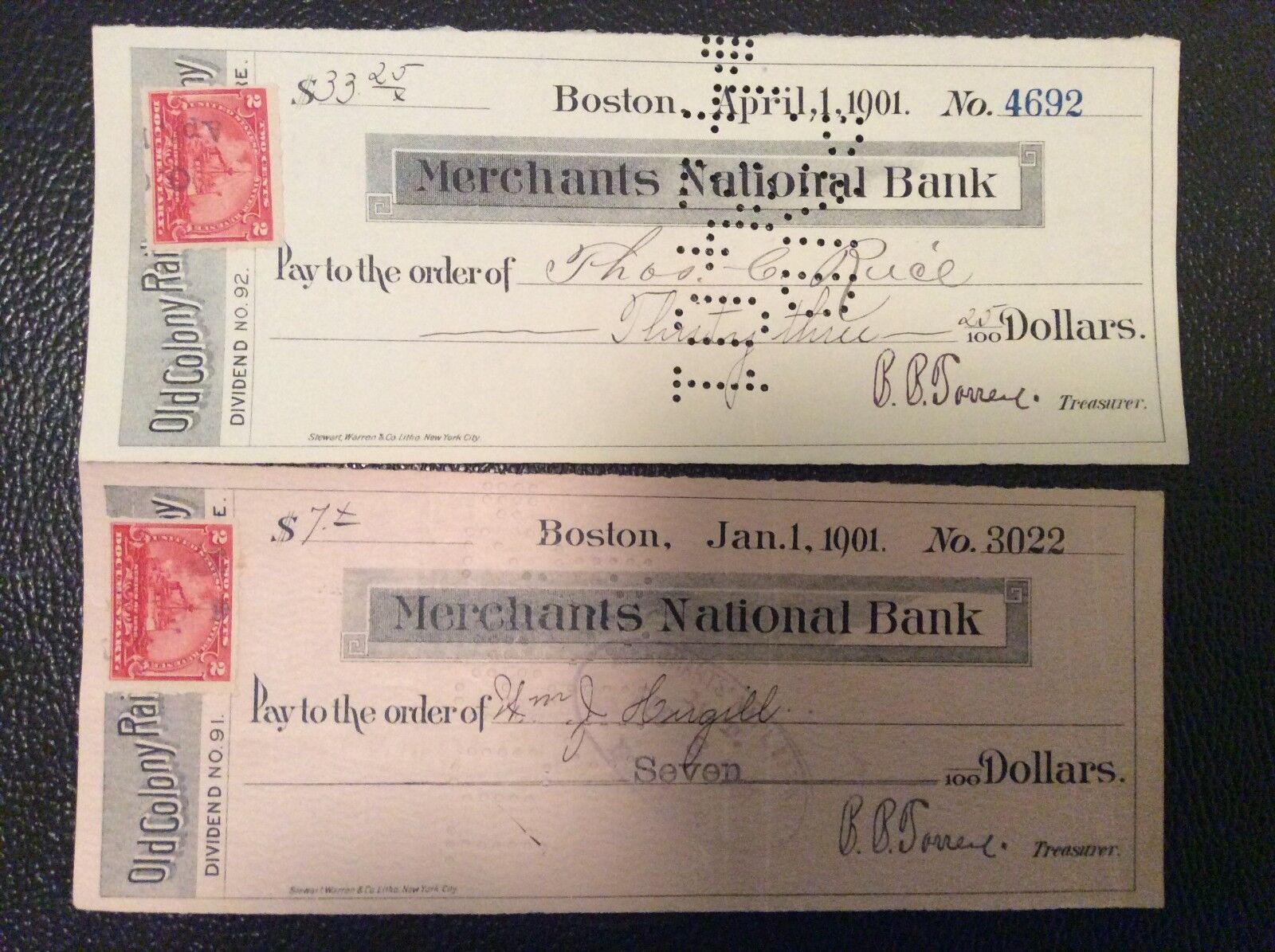-40%
RARE RR Cover c 1850 Michigan Southern Railroad Great American US Mail & Express
$ 261.36
- Description
- Size Guide
Description
VERY RARE Original Advertising Cover / EnvelopeMichigan Southern Rail Road
Great American U.S. Mail and Express Route
ca 1850
For offer, a nice old advertising cover. Fresh from an estate in Upstate / Western NY. Never offered on the market until now.
Vintage, Old, antique, Original -
NOT
a Reproduction - Guaranteed !!
This came with some old letter from the 1840s and 1850s. I could not find one of these anywhere. Great steam engine train graphic printed at top. Gives distances from Chicago to La Porte, South Bend, Elkhart, [ Indiana ], White Pigeon, Sturges, Sold water, Jonesville, Hillsdale, Adrian, Monroe, Toledo, Clyde, Monroeville, Newark, Zanesville [ Ohio ], Columbus, Wheeling, Pittsburgh, Harrisburg, Philadelphia [ Pennsylvania ], Baltimore, Washington D.C., Cleveland, Erie, Dunkirk, Buffalo [ New York ], Albany, Boston, New York, and Do. via Phila. Small envelope - measures 4 1/8 x 2 1/2 inches. Back has small wax seal originally used to seal the cover. In good condition overall. A few rips, with light archival repairs to them. Please see photos for details.
If you collect Americana advertisement ad, 19th century American post office history,
Americana advertisement ad, RR transportation, moveable type printing, etc., this is one you will not see again soon. A nice piece for your paper or ephemera collection. Perhaps some genealogy research information as well.
Combine shipping on multiple bid wins!
2412
The Lake Shore and Michigan Southern Railway, established in 1833 and sometimes referred to as the Lake Shore, was a major part of the New York Central Railroad's Water Level Route from Buffalo, New York, to Chicago, Illinois, primarily along the south shore of Lake Erie (in New York, Pennsylvania and Ohio) and across northern Indiana. The line's trackage is still used as a major rail transportation corridor and hosts Amtrak passenger trains, with the ownership in 1998 split at Cleveland between CSX to the east, and Norfolk Southern in the west.
History
Early history: 1835–1869
Part of the original route, now in Sylvania, Ohio
Toledo to Chicago
Drawing of the Erie and Kalamazoo Railroad
Drawing of the Erie and Kalamazoo Railroad
On April 22, 1833, the Erie and Kalamazoo Railroad was chartered in the Territory of Michigan to run from the former Port Lawrence, Michigan (now Toledo, Ohio), near Lake Erie, northwest to Adrian on the River Raisin. The Toledo War soon gave about one-third of the route to the state of Ohio. Trains commenced operating, pulled by horses, on November 2, 1836; the horses were replaced by a newly arrived steam locomotive, Adrian No. 1, in August 1837.
The Buffalo and Mississippi Railroad was chartered in Indiana on February 6, 1835, to run from Buffalo, New York, to the Mississippi River. The name was changed February 6, 1837, to the Northern Indiana Railroad, which would run from the eastern border of Indiana west to Michigan City on Lake Michigan. Some grading between Michigan City and La Porte was done in 1838, but money ran out.
1850 map of the Michigan Southern Rail Road with connections
LSMS double arch bridge over the East Branch of the Huron River, just west of Norwalk, Ohio. A similar, but smaller-sized bridge, exists to the east in the Ohio town of Wakeman.
Around 1838, the state of Michigan started to build the Southern Railroad, running from Monroe on Lake Erie west to New Buffalo on Lake Michigan. The first section, from Monroe west to Petersburg, opened in 1839. Extensions opened in 1840 to Adrian and 1843 to Hillsdale. On May 9, 1846, the partially completed line was sold to the Michigan Southern Rail Road, which changed the planned western terminal to Chicago using the charter of the Northern Indiana Railroad. The grading that had been done was not used, as the grade was too steep, and instead the original Buffalo and Mississippi Railroad charter was used west of La Porte, IN. The Michigan Southern leased the Erie and Kalamazoo on August 1, 1849, giving it a branch to Toledo, OH and a connection to planned railroads east from Toledo.
Due to lobbying by the Michigan Central Railroad, a competitor of the Michigan Southern, the latter's charter prevented it from going within two miles of the Indiana state line east of Constantine. However the most practical route went closer than two miles west of White Pigeon. To allow for this, Judge Stanfield of South Bend, IN bought the right-of-way from White Pigeon to the state line, and leased it to the railroad company for about 10 years until the charter was modified to allow the company to own it.
The Northern Indiana and Chicago Railroad was chartered on November 30, 1850. Its initial tracks, from the Michigan Southern at the state line running west-southwest to Elkhart, IN then west through Osceola and Mishawaka to South Bend, IN, opened on October 4, 1851. The full line west to Chicago opened on February 20, 1852, (running to the predecessor of today's LaSalle Street Station, together with the Chicago and Rock Island Railroad north of Englewood, IL). A more direct line was soon planned from Elkhart east to Toledo, and the Northern Indiana Railroad was chartered in Ohio on March 3, 1851. On July 8, 1853, the Ohio and Indiana companies merged, and on February 7, 1855, the Northern Indiana and Chicago Railroad and the Buffalo and Mississippi Railroad were merged into the Northern Indiana Railroad. On April 25, 1855, that company in turn merged with the Michigan Southern Rail Road to form the Michigan Southern and Northern Indiana Railroad. In 1858 [1] the new alignment (Northern Indiana Air Line) from Elkhart, IN east to Air Line Junction in Toledo, OH was completed. The company now owned a main line from Chicago to Toledo, with an alternate route through southern Michigan east of Elkhart, and a branch off that alternate to Monroe, MI. Also included was the Detroit, Monroe and Toledo Railroad, leased July 1, 1856, and providing a branch from Toledo past Monroe to Detroit.
Erie to Cleveland
The Franklin Canal Company was chartered May 21, 1844, and built a railroad from Erie, PA southwest to the Ohio border. The Cleveland, Painesville and Ashtabula Railroad was incorporated February 18, 1848,[1] to build northeast from Cleveland, OH to join the Canal Company's railroad at the state line, and the full line from Erie to Cleveland opened November 20, 1852. The Cleveland, Painesville and Ashtabula bought the Franklin Canal Company on June 20, 1854.
Buffalo to Erie
The Buffalo and State Line Railroad was incorporated October 13, 1849, and opened January 1, 1852, from Dunkirk, NY west to Pennsylvania. The rest of the line from Dunkirk to Buffalo opened on February 22. The Erie and North East Railroad was chartered April 12, 1842, to build the part from the state line west to Erie, PA, and opened on January 19, 1852. On November 16, 1853, an agreement was made between the two railroads, which had been built at 6 ft (1,829 mm) broad gauge, to relay the rails at 4 ft 8 1⁄2 in (1,435 mm) standard gauge to match the Franklin Canal Company's railroad (see below) on the other side of Erie, and for the Buffalo and State Line to operate the Erie and Northeast. This would result in through passengers no longer having to change trains at Erie, and on December 7, 1853, the Erie Gauge War began between the railroads and the townspeople. On February 1, 1854, the relaying was finished and the first train passed through Erie. On May 15, 1867, the two companies between Buffalo and Erie merged to form the Buffalo and Erie Railroad.
Cleveland to Toledo
The Junction Railroad was chartered March 2, 1846, to build from Cleveland west to Toledo. The Toledo, Norwalk and Cleveland Railroad was chartered March 7, 1850, to build from Toledo east to Grafton on the Cleveland, Columbus and Cincinnati Railroad. The latter company opened on January 24, 1853, finally forming a continuous Buffalo-Chicago line. On September 1 the two companies merged to form the Cleveland and Toledo Railroad, with the Junction Railroad becoming the Northern Division and the Toledo, Norwalk and Cleveland the Southern Division. The Northern Division opened from Cleveland west to Sandusky on October 24, 1853, and the rest of the way to Toledo on April 24, 1855. The Northern Division was abandoned west of Sandusky due to lack of business, but the track was relaid in 1872, merging with the Southern Division at Millbury, east of Toledo. In 1866 the Southern Division east of Oberlin was abandoned and a new line was built to Elyria on the Northern Division, ending the use of the Cleveland, Columbus and Cincinnati Railroad.
Consolidations
In October 1867 the Cleveland, Painesville and Ashtabula Railroad leased the Cleveland and Toledo Railroad. The CP&A changed its name to the Lake Shore Railway on March 31, 1868, and on February 11, 1869, the Lake Shore absorbed the Cleveland and Toledo. On April 6 the Michigan Southern and Northern Indiana Railroad and Lake Shore merged to form the Lake Shore and Michigan Southern Railway, which absorbed the Buffalo and Erie Railroad on June 22, giving one company the whole route from Buffalo to Chicago. The main route passed through Dunkirk, NY, Erie, PA, Ashtabula, OH, Cleveland, OH, Toledo, OH, Waterloo, IN and South Bend, IN. An alternate route (the Sandusky Division) in Ohio ran north of the main line between Elyria and Millbury (not all track was laid until 1872). From Toledo to Elkhart, the Old Road ran to the north, through southern Michigan, and the through route was called the Air Line Division or Northern Indiana Air Line. Along with various branches that had been acquired (see below), the Monroe Branch ran east from Adrian, MI to Monroe, where it intersected the leased Detroit, Monroe and Toledo Railroad. At some point the original line to Toledo was abandoned west of the branch to Jackson, MI (Palmyra and Jacksonburgh Railroad), with the new connection at Lenawee Junction, the crossing between that branch and the line to Monroe.[2]
Lake Shore and Michigan Southern Railway: 1869–1914
Gold Bond of the Lake Shore and Michigan Southern Railway Company, issued 1 June 1897.
The Elkhart, Indiana shops in 1903.
0-10-0 "Decapod" switching locomotive of 1907
Around 1877, Cornelius Vanderbilt and his New York Central and Hudson River Railroad gained a majority of stock of the Lake Shore and Michigan Southern Railway. The line provided an ideal extension of the New York Central main line from Buffalo west to Chicago, along with the route across southern Ontario (Canada Southern Railway and Michigan Central Railroad). On December 22, 1914, the New York Central and Hudson River Railroad merged with the Lake Shore and Michigan Southern Railway to form a new New York Central Railroad.
While the original main line was to the south of Sandusky Bay between Toledo and Elyria, the northern alignment (the Sandusky Division) eventually became the main line.
New York Central Railroad: 1914–1968
On December 22, 1914, New York Central and Hudson River Railroad merged with the Lake Shore and Michigan Southern Railway to form the New York Central Railroad (NYC) which is the main line running south between Toledo and Elyria, eventually passing by north through the Sandusky Division.
Post-NYC: 1968–
In 1968 the New York Central merged into Penn Central, and in 1976 it became part of Conrail. In 1976, the Southern Division from Elyria to Millbury was abandoned, with parts of the former right of way now in use as a recreational trail, the North Coast Inland Trail. Under Conrail, the Lake Shore main line was part of the New York City-Chicago Chicago Line.
In 1998 Conrail was split between CSX and Norfolk Southern. The Chicago Line east of Cleveland, Ohio went to CSX, and was split into several subdivisions – the Lake Shore Subdivision from Buffalo, New York to Erie, Pennsylvania, the Erie West Subdivision from Erie to east of Cleveland, Ohio, and the Cleveland Terminal Subdivision into downtown Cleveland. From the former Cleveland and Pittsburgh Railroad junction in Cleveland west to Chicago, the line is now Norfolk Southern's Chicago Line.
Amtrak's New York City-Chicago Lake Shore Limited runs along the full route from Buffalo west. The Capitol Limited joins in Cleveland at the "Amtrak Connection" from the former PRR C&P line, just east of the present Cleveland Station (MP 181), on its way from Washington, D.C. to Chicago. Passenger trains along the route originally terminated at LaSalle Street Station, but now run to Union Station, switching to the parallel former Pittsburgh, Fort Wayne and Chicago Railway (Pennsylvania Railroad) at a crossover in Whiting, Indiana (41.68480°N 87.49534°W) to get there.
The Ashtabula River Railroad Disaster
Main article: Ashtabula River Railroad Disaster
The Ashtabula River Railroad Disaster, also called the Ashtabula Horror, was the worst train disaster in American history when it occurred in far northeastern Ohio on 29 December 1876 at 7:28 p.m. The Lake Shore and Michigan Southern Railway Train No. 5, The Pacific Express, left a snowy Erie, Pennsylvania, on the afternoon of December 29, 1876. As The Pacific Express plowed through the snow and crossed a bridge over the Ashtabula River, about 100 yards (91 m) from the railroad station at Ashtabula, Ohio, the passengers heard a terrible cracking sound. In just seconds, the bridge fractured and the train plunged 70 feet (21 m) into a watery abyss.
The lead locomotive, The "Socrates" made it across the bridge, while the second locomotive, The "Columbia" and 11 railcars including two express cars, two baggage cars, one smoking car, two passenger cars and three sleeping cars and a caboose fell into the ravine below, then igniting a raging fire. The wooden cars were set aflame by kerosene-heating stoves and kerosene burning lamps. Some cars landed in an upright position and within a few minutes small localized fires became an inferno. The fire then caused the ice on the creek to melt and sent the wreckage even further into the freezing water.
The rescue attempt was feeble at best because of the ill-preparedness of the nearby station to respond to emergencies. Of 159 passengers and crew on board that night, 64 people were injured and 92 were killed or died later from injuries sustained in the crash (48 of the fatalities were unrecognizable or consumed in the flames.) It is unclear how many died of the fall, or drowning separate from the blaze.
The famous hymnwriter Philip Bliss and his wife lost their lives in the disaster.
Twenty years later, in Ashtabula's Chestnut Grove Cemetery, a monument was erected to all those "unidentified" who perished in the Ashtabula Railroad disaster.
The disaster helped focus efforts to draw up standards for bridges including adequate testing and inspection. The bridge, designed jointly by Charles Collins and Amasa Stone, was the first Howe-type wrought iron truss bridge built. Collins was reluctant to go through with building the bridge calling it "too experimental." But he bowed to pressure from the railroad to approve construction.[citation needed]
Branches
A major branch of the LS&MS extended from Northeaster Ohio to the coal and oil fields of northwestern Pennsylvania terminating near Brookville, PA. Originally the line extended to the oil fields and refineries on the Allegheny River at Franklin and Oil City.
The line was later extended from Polk Junction, West of Franklin, to Rose, just west of Brookville, PA. Also added was a connector South from Franklin to the Allegheny River crossing on the new extension. This line included perhaps the most impressive engineering structures on the LS&MS (as well as the later NYC) with several large trestles, bridges and tunnels near Brookville, including a bridge-tunnel-bridge-tunnel-fill combination near Piney, and two magnificent trestles West of Brookville near Corsica. The New York Central used trackage rights over the Pennsylvania Railroad and B&O to connect from Rose to NYC lines at Clearfield, PA.
There were several mines on this line near Brookville, as well as a connection to the Lake Erie, Franklin and Clarion (LEF&C) at Sutton, and connections to the Pennsylvania Railroad and, via the Pennsy, to the Pittsburgh & Shawmut at Brookville.
Once coal traffic dried up in the late 1990s, this line was severed and cut back to the mine at Piney. Many of the larger trestles were taken out in the late 2000s, reportedly on orders of the PUC, although the bridge across the Clarion River survived, as of 2015.
Station listing
State
Milepost
City
Station
Lat/long
Opening date
Connections and notes
New York
QDN1.9
Buffalo
Exchange Street Station
42.8783°N 78.8738°W
Amtrak Empire Service and Maple Leaf Lake Shore Railway Museum
Lackawanna
Lackawanna
Blasdell
Blasdell
Bay View
Athol Springs
Athol Springs
Lake View
Lake View
Derby
Derby
QD21.4
Angola
Angola
Farnham
Farnham
QD27.0
Irving
Irving
QD31.4
Silver Creek
Silver Creek
Waites Crossing
QD40.3
Dunkirk
Dunkirk
Connection to Titusville Branch; Former Union Station shared by Erie Railroad?
Van Buren
Brocton
Brocton
Portland
Portland
West Portland
West Portland
QD57.5
Westfield
Westfield
42.194224°N 79.34552°W
On NRHP as "Lake Shore and Michigan Southern Railway Station"
Forsyth
Forsyth
QD65.3
Ripley
Ripley
State Line
State Line
Pennsylvania
QD73.0
North East
North East
42°12′36.2″N 79°50′19.2″W
Lake Shore Railway Museum
Moorhead
Harbor Creek Twp.
Harbor Creek
Wesleyville
Wesleyville
QD86.9
Erie
Erie
42°7′15.24″N 80°4′55.2″W
Amtrak Lake Shore Limited
Dock Junction
Swanville
Swanville
QD97.8
Fairview Twp.
Fairview
North Girard
Girard Junction
Springfield Twp.
Springfield
Ohio
QD114.5
Conneaut
Conneaut
41.949722°N 80.559167°W
Conneaut Historic Railroad Museum
Amboy
Kingsville
Kingsville
QD127.7
Ashtabula
Ashtabula
41°52′33″N 80°47′33″W
Currently a CSX signal storage house
Saybrook
QD137.1
Geneva
Geneva
Unionville
Unionville
QD142.5
Madison
QD147.5
Perry
QD153.2
Painesville
QD159.4
Mentor
Mentor
41.678889°N 81.338333°W
On NRHP as the "Lake Shore and Michigan Southern RR Depot and Freight House"
QD163.7
Willoughby
Willoughby
QD168.3
Wickliffe
Wickliffe
Noble
Cleveland
Collinwood
East 105th Street
QD180.5
East 26th Street
Union Depot
Detroit Avenue
West Park
Belt Junction
Berea
Berea
41°22′52″N 81°51′16″W
Union Depot, with Big Four Railway
Olmsted Falls
Olmsted Falls
Shawville
Elyria
Elyria
Amtrak Lake Shore Limited and Capitol Limited
Amherst
Amherst
Brownhelm Twp.
Brownhelm
Vermilion
Vermilion
Ceylon
Ceylon
Huron
Huron
Sandusky
Sandusky
41°26′26″N 82°43′7″W
Amtrak Lake Shore Limited and Capitol Limited; NRHP named Lake Shore and Michigan Southern Railroad Depot
Venice
Bay Bridge
Danbury
Danbury
Gypsum
Gypsum
Port Clinton
Port Clinton
La Carne
La Carne
Oak Harbor
Oak Harbor
Rocky Ridge
Rocky Ridge
Graytown
Graytown
Martin
Millbury
Millbury Junction
Northwood
Vickers
Toledo
Toledo
41°38′16″N 83°32′30″W
Amtrak Lake Shore Limited and Capitol Limited
Air Line Junction
Nasby
Holland
Holland
Swanton
Swanton
Delta
Delta
Wauseon
Wauseon
41.547222°N 84.136944°W
Pettisville
Pettisville
Archbold
Archbold
Stryker
Stryker
Bryan
Bryan
Amtrak Lake Shore Limited
Melbern
Melbern
Mina
Edgerton
Edgerton
Indiana
Butler
Butler
Waterloo
Waterloo
Amtrak Lake Shore Limited and Capitol Limited
Corunna
Corunna
Kendallville
Kendallville
Brimfield
Brimfield
Wawaka
Wawaka
Ligonier
Ligonier
Grismore
Millersburg
Millersburg
Goshen
Goshen
Elkhart
Elkhart
41.6806°N 85.9717°W
Amtrak Lake Shore Limited and Capitol Limited; National NYCRR Museum
Osceola
Osceola
Mishawaka
Mishawaka
South Bend
South Bend
41.6693°N 86.2545°W
Lydick
Terre Coupee
New Carlisle
New Carlisle
Rolling Prairie
Rolling Prairie
La Porte
La Porte
Pinola
Durham
Otis
Otis
Burdick
Chesterton
Chesterton
41°36′41″N 87°3′16″W
On NRHP as the "New York Central Railroad Passenger Depot"
Porter
Porter
Burns Harbor ?
Dune Park
Portage
Ogden Dunes
41.6088°N 87.1852°W
South Shore Line
Gary
Miller
Gary
41.36203°N 87.201307°W
Curtis
Pine
Buffington
East Chicago
Indiana Harbor
?
Mahoning
Whiting
Whiting
Hammond
Robertsdale
Illinois
Chicago
East Side
South Chicago
Grand Crossing
71st Street
Park Manor
Englewood
41.7797°N 87.627°W
31st Street
LaSalle Street Station
41.87553°N 87.63239°W
Metra Rock Island District
See also
Railways portal
LeGrand Lockwood, company treasurer
John E. Gunckel, passenger agent
Competitors
Michigan Central Railroad
New York, Chicago and St. Louis Railroad (Nickel Plate Road)
